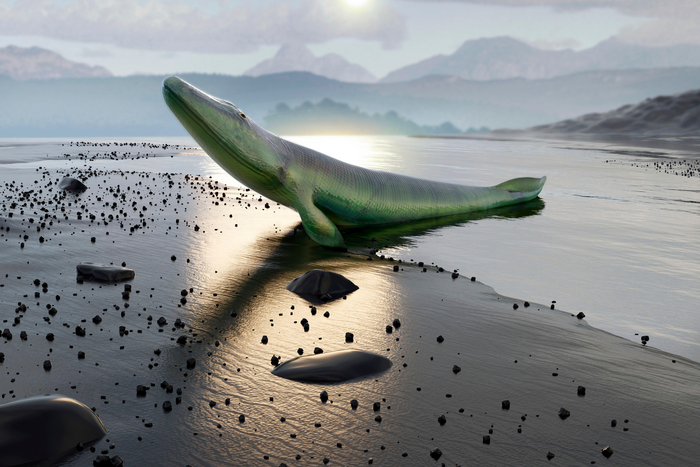
Earliest land animals had fewer skull bones than fish
Tetrapods are vertebrates (backboned animals) that have four limbs or leg-like structures. They include all amphibians, reptiles, birds and mammals and are thought to have evolved from lobe-finned fish way back in the Devonian Period, some 400 million years ago. The earliest tetrapods were aquatic and adapted to life in the water, but over time new species evolved that became more terrestrial and less dependent on watery environments for feeding, breeding and surviving.
In a study published in the journal Science Advances, researchers from the University of Bristol, Barcelona’s Universitat Pompeu Fabra and University College London investigated the skulls of over 100 living and fossil tetrapods to understand how skull bone arrangements had changed during the evolution of this important group. The scientists found that the skulls of tetrapods had far fewer bones than are found in the skulls of fish, both extinct and living, but that these bones had more complex connections between them than are found in fish skulls.
“Tetrapod skulls generally have fewer skull bones than their fish ancestors, but simply counting the number of bones misses some important data,” said study lead author James Rawson. “We used a technique called network analysis, where the arrangement of skull bones – which bones connect to which – is recorded in addition to bone number.”
“Traditionally, anatomy research has been mostly descriptive or qualitative. Network analysis provides a sound mathematical framework to quantify anatomical relations among bones: a kind of data often overlooked in most studies on morphological evolution,” explained study co-author Dr. Borja Esteve-Altava.
One might expect that having fewer bones would make skull organization simpler, but this is not what the researchers found. They concluded that, for tetrapods, having fewer skull bones actually made the organization of their skulls more complex.
“It might seem strange, but having fewer bones means each of those bones must connect with more of its neighbors, resulting in a more complex arrangement,” said Rawson. “Modern frogs and salamanders had the most complex skulls of all the animals we studied.” The skulls of the earliest tetrapods also became more consolidated into a single unit, whereas their fish ancestors had skulls made of several distinct sections.
By looking at the variety of skull bone arrangements over time, the authors also discovered that the origin of tetrapods coincided with a decrease in this variety. “We were surprised to find these changes to the skull seemed to limit tetrapod evolution, rather than promoting radiation to new habitats on land,” said study senior author Professor Emily Rayfield. “We think that the evolution of a neck, extinction events or a bottleneck in skull development may be responsible.”
“We also see a similar drop in structural variability for the limb bones in early tetrapods, but the drop in the limbs happens 10 million years earlier,” said Rawson. “It seems that different factors were affecting skull and limb evolution in early tetrapods, and we have so much more to learn about this crucial time in our own evolutionary history.”
The authors of the study conclude that the cranial evolution of tetrapods is characterized by increasing complexity in terms of bone arrangements but decreasing variety. They say that, rather than promoting the diversification of life on land, these changes in skull anatomy actually limited the evolution of tetrapods for millions of years.
Image Credit: Science Photo Library / Alamy Stock Photo image ID (2G70HK2) Original artist: Mark Garlick
—
By Alison Bosman, Earth.com Staff Writer












